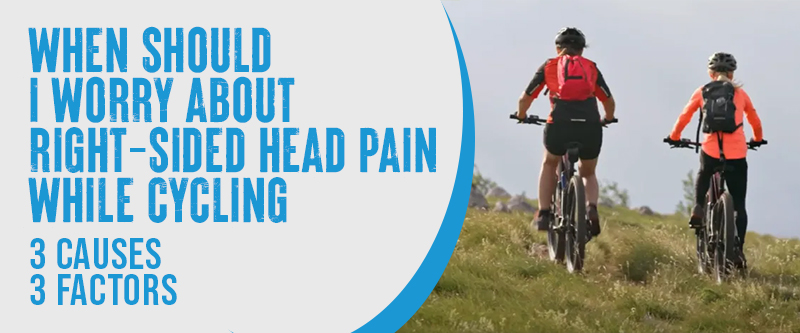Physical activity, like cycling, can maintain fitness. However, increased exertion can cause blood flow to rise in the head, neck, and scalp muscles, potentially leading to exertional headaches.
A right-sided headache should be taken seriously if it is severe and sudden and lasts longer than two days. Such situations call for the consultation of a healthcare professional.
This guide offers in-depth insights into identifying the causes of your headaches, knowing when to consult a healthcare professional, and managing strategies to prevent future discomfort.
Right-Sided Head Pain Cycling: 6 Common Causes Explained

Cycling is a wonderful method to stay in shape and relish the great outdoors. Occasionally, you may encounter discomfort on the right side of your head during cycling. While this may cause concern, unraveling the underlying causes can aid in its prevention.
Cervicogenic Headaches
Headaches frequently stem from neck muscle tension, causing pain that radiates to one side of the head. This discomfort might be exacerbated by sporadic light or noise sensitivity. Poor cycling posture is among the triggers for these headaches.
Going on extended rides without sufficient breaks to rest and stretch the muscles can also play a role. Tackling these elements can help reduce the occurrence of these cycling-induced headaches.
Exertional Headaches
Exertion headaches, triggered by physical activities like cycling, manifest as a throbbing sensation on one side of the head, often beginning during or post-exercise.
Though brief, spanning minutes to hours, exertion headaches can be distinguished from cervicogenic headaches, which stem from the neck. These headaches are prevalent among cyclists during intense physical exertion.
External Compression Headaches
Headaches may result from the pressure your helmet puts on your scalp. Tight helmet fit and extended wear are common culprits.
Those affected often feel pain in areas where the helmet presses. Removing the helmet typically brings relief as the scalp recovers from the strain.
Right-Sided Head Pain in Cycling: Exploring Contributing Factors
While cycling, cyclists frequently encounter headaches. Chronic health issues, such as arthritis or trigeminal neuralgia, may cause headaches on the right side. Recognizing factors is vital for cyclists looking for relief and prevention methods. Here are some prevalent causes:
Dehydration
Staying hydrated is crucial for cyclists. When you don’t drink enough water, your body can suffer.
- The Significance of Hydration: Maintaining adequate water intake is crucial for sustaining normal bodily functions, including optimal brain performance.
- Symptoms: Dehydration symptoms include headaches, dizziness, dry mouth, fatigue, and dark yellow urine.
Neck Strain
Your cycling posture can strain your neck, causing headaches on one side as well as vision problems.
The posture while cycling impacts the neck muscles; excessive forward bending can strain them. Prolonged stiffness in the neck may lead to discomfort.
Helmet
A poor helmet can contribute to right side head pain while cycling in several ways:
- Improper Fit: If the helmet is too tight or loose, the weight may be unevenly distributed, leading to pain on one side.
- Inadequate Padding: Insufficient or worn-out padding inside the helmet can lead to direct contact with hard surfaces, causing discomfort and pain.
- Imbalanced Weight: A poorly designed or improperly adjusted helmet might not sit evenly on your head, causing a strain on one side of your neck and head.
- Pressure on Nerves: A poorly fitted helmet can pressure nerves around the scalp and forehead, contributing to localized pain.
Ensuring your helmet fits correctly, with adequate padding and balanced weight distribution, can help prevent head pain and enhance overall comfort while cycling.
Right-Sided Head Pain While Cycling: When to Seek Medical Attention
Experiencing head pain on the right side while cycling can be alarming and may cause a medical evaluation. A good understanding of when to seek medical help is crucial to your health and cycling performance. Explore this guide to discover the indicators and symptoms that require medical attention.
Symptoms to Watch
Pain in the right side of the head while cycling may sometimes signal a more serious problem. Here are some symptoms that show you should see a doctor.
- Persistent Pain: If your headache lasts longer than usual and doesn’t go away with rest or hydration, it could be a sign of something more serious.
- evere, Sudden Onset:S If you experience a sudden, severe headache that doesn’t get better with rest or drinking water, seek medical help.
- Accompanying Symptoms: Watch for other symptoms, such as nausea, vomiting, or changes in vision.
Potential Serious Conditions

Sometimes, right-sided head pain can be caused by serious conditions. It’s important to know what to look out for.
Concussion
Concussions are brain injuries that occur if you hit your head during a fall or accident. Here are some symptoms of concussion:
- Headache.
- Confusion.
- Dizziness.
Other Neurological Issues
Rarely, your head pain might be because of other neurological problems. Here are some signs that may show More Serious Conditions:
- Persistent or worsening headache.
- Sudden weakness or numbness in other parts of the body.
- Difficulty speaking or understanding speech.
- Vision problems.
If these symptoms persist, take the following steps: Stop cycling immediately, seek medical attention promptly, and avoid activities that may cause another head injury.
Cycling-Related Right-Sided Headaches: 3 Prevention And Management
Cycling is a great way to stay fit, but right-sided head pain can sometimes occur. Knowing when to worry and how to prevent it is important for your health. This blog post will discuss prevention and management tips to help you enjoy your rides pain-free.
Pre-Ride Preparations
Getting ready before your ride is crucial to avoid head pain.
- Proper Hydration Strategies: Drink plenty of water before you cycle. This helps keep your body hydrated and reduces the risk of headaches.
- Warm-Up Exercises Targeting Neck and shoulders: Stretch your neck and shoulders to loosen tight muscles. This can prevent tension that might cause headaches.
- Helmet Fitting Tips: The helmet should sit level on your head. The straps should be snug but not too tight, and the helmet shouldn’t move when you shake your head.
During the Ride

How you ride can also affect whether you get head pain.
- Maintaining a Relaxed Posture: Keep your shoulders relaxed and avoid hunching. This helps reduce tension in your neck and head.
- Regular Hydration Breaks: Take short breaks to drink water, especially on long rides. Staying hydrated can prevent headaches.
- Listening to Your Body: Pay attention to how you feel. If you notice early signs of a headache, take a break and rest.
Post-Ride Care
After your ride, it’s important to care for your body to prevent head pain.
- Cool-Down Exercises for Shoulders and Neck: Stretch your shoulders and neck again to relax any muscles that tensed up during the ride.
- Nutrition Recovery Strategies: Eat a healthy snack to replenish your energy. Proper recovery helps your body heal and prevents headaches.
Following this, prevention and management tips can reduce the chances of right-sided head pain during cycling. Stay hydrated, stretch regularly, and listen to your body to enjoy more comfortable rides.
Conclusion
In this comprehensive guide, we’ve delved into various aspects of headaches that cyclists may encounter. From common types like cervicogenic and exertional headaches to factors such as dehydration, neck strain, and helmet fit.
We’ve also highlighted crucial signs that demand immediate medical attention. While cycling is enjoyable and beneficial, prioritizing your health is paramount. Persistent or severe pain should always be addressed; seek professional guidance promptly.
By preparing adequately, riding cautiously, and practicing post-ride care, it is possible to minimize the possibility of experiencing headaches while cycling. Keep these insights in mind as you prepare for your next cycling adventure. Pedal safely and enjoy the ride.
FAQs
What Are The Symptoms Of A Hormonal Headache?
Menstrual migraines’ symptoms include dull to severe head pain, heightened sensitivity to light, sound, and smells, tenderness or soreness in the scalp, loss of appetite, blurred vision, fatigue, upset stomach, and abdominal pain.
Why Does The Right Side Of My Head Hurt When I Exercise?
Exertion headaches entail pain experienced during or right after physical activity. They manifest rapidly and typically dissipate within minutes to a few hours, occasionally lasting up to a few days. While no underlying disease or disorder is usually associated, consulting with a healthcare provider is advisable to eliminate any potential issues.


